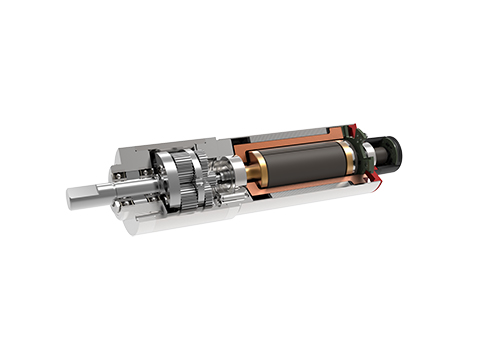
Posted to News on 25th Mar 2025, 13:00
Choosing the right motor for aerospace applications
For aerospace applications, brushless DC (BLDC) motors are commonly used because of the performance they provide, yet the choice between slotted or slotless designs remains. With differences in torque, size and weight, precision control and durability, there's a lot at stake, as Adrien Mettraux, Industry Manager at Portescap, explains.

From flying at high altitudes of 30,000 feet or more, to the g-force of high acceleration, or the demands of landing, strength and reliability in aircraft design are essential. This means that the components and systems integral to these aircraft must meet stringent standards, and their designs are commonly a crucial factor in optimising flight performance.
Of particular importance, motion systems, driven by compact electric motors, are used to power a plethora of functions across modern aircraft. This could range from fuel delivery and flight control, through to climate management onboard to achieve a safe and comfortable environment.
Motion systems must not only deliver the necessary power, reliability, and long life required to drive these applications, but as is critical to all aspects of aircraft design, they must do so in a small, lightweight envelope. Depending on each application's required level of control, these motion systems are also tasked to achieve exacting levels of precision. For these reasons, BLDC motors are the typical choice.
By eliminating mechanical brushes, BLDC motors experience less wear leading to a longer life, only limited by the life of the bearings. These motors are generally more compact and more powerful for the same envelope. These motors also increase control precision as they rely on electronic controllers to manage current and voltage. BLDC designs are either slotted, where the wire coil is inserted into lamination slots, or slotless, which uses a self-supported coil design. This distinction is crucial for aerospace applications, and the advantages and drawbacks of each design are central in their selection.
Slotted and slotless designs
In slotted motors, the stator is manufactured from thin sheets of laminated steel. The laminations form a complete stack, and the copper windings that channel the electrical current to create the electro-magnetic field are placed within slots. These typically comprise iron teeth, which the windings are wound around, and their role is to provide magnetic paths that lead to strong interaction with the rotor's magnets. This process is enhanced as the design minimises the air gap between the stator and the magnet in the rotor, resulting in high magnetic induction.
Alternatively, in slotless motors, the copper windings are usually self-bonded and self-supportive in a cylindrical design, which is inserted directly into the air gap between the rotor and the cylindrical lamination stack.
While BLDC slotted motor technologies are designed to provide high torque and deliver at least 10 times the maximum continuous torque without magnetic saturation, slotted motors optimize torque density. This is achieved thanks to the concentrated magnetic flux and a smaller air gap that increases electro-magnetic interaction.
Slotless designs can minimise this difference through a larger magnet design, and high strength magnets, like NdFeB. However, with the coil positioned inside the stator slots, this enables slotted designs to achieve lower thermal resistance, increasing torque through improved heat dissipation. As a result, with a slotted BLDC design, a comparatively smaller, lighter motor can typically be used.
Slotless motors do not experience magnetic saturation due to their larger air gap, which lowers flux density. Additionally, their cylindrical lamination design helps avoid the risk of localized saturation typically found in slotted motors.
Precision and efficiency
However, a crucial advantage of the slotless BLDC motor is the precision control that can be achieved in comparison to a slotted motor. While the iron teeth of a slotted design help to optimize torque density, they also cause cogging. The interaction between the magnets and stator teeth creates stable position and additional torque is required to break the magnet attraction. This effect creates steps, a relatively jerky, pulsating effect, especially at low speeds.
While skewing the laminations on a slotted design can minimise this effect, a slotless motor, on the other hand, operates with zero cogging. Free of iron teeth, the rotor in a slotless design benefits from continuous permeance - the passage of magnetic flux - and therefore achieves smooth rotation, crucial when precise control is required.
A slotless design also benefits from lower iron lamination volume, leading to a reduction in eddy currents and hysteresis losses, which have a particular effect at high speed. However, as slotted motors achieve improved thermal conductivity, and therefore dissipate heat more effectively, this helps to maintain performance under higher loads.
As slotless motors typically use a larger magnet to compensate for the lower magnetic induction of the coil, this also requires a larger and heavier rotor, resulting in higher inertia. This is another consideration when deciding which motor technology to use, as certain applications, such as trim actuators for autopilot systems, may require a very low inertia to achieve high sensitivity.
However, a slotless design allows better performance for small motors, between 8-13mm outer diameter, by improving the coil cooper filling factor. Alternatively, in slotted motors of the same size, the slots are generally too small to allow winding and filling with cooper.
Durability and reliability
Wherever these motors are used on an aircraft, reliability and durability are crucial. Slotted motor topology is inherently robust as the coil is inserted in the lamination, and they can be further reinforced by over-molding the wound stator. This makes these designs best suited to handling harsh environments, including those involving high shock and vibration.
Slotless motors can also be designed to survive many of the same high humidity and salt fog conditions required under DO-160 standards, but they will have inherently lower survivability than their slotted equivalents.
Heat resistance is also crucial to many aircraft applications. Slotted coils can handle high temperatures up to 220degC, making them suitable for specific uses where high resistance is important. While slotless designs can handle temperatures up to 150degC, the self-supported nature of the coil design makes them more prone to collapse at extreme temperatures.
Motion engineering expertise
The balance between the capabilities of slotted and slotless motors can be a fine line, especially when considering the critical nature of aviation applications. Advice in design can maximize the value in developing a motion solution by minimising the number of design iterations and time to market, as well as optimizing the performance of the system.
Either slotted or slotless motor designs could be the most appropriate - and the application might also benefit from custom motion system development, among the variety of wider design considerations. Portescap continually works on aviation projects to optimize motion system designs for aircraft around the world.








